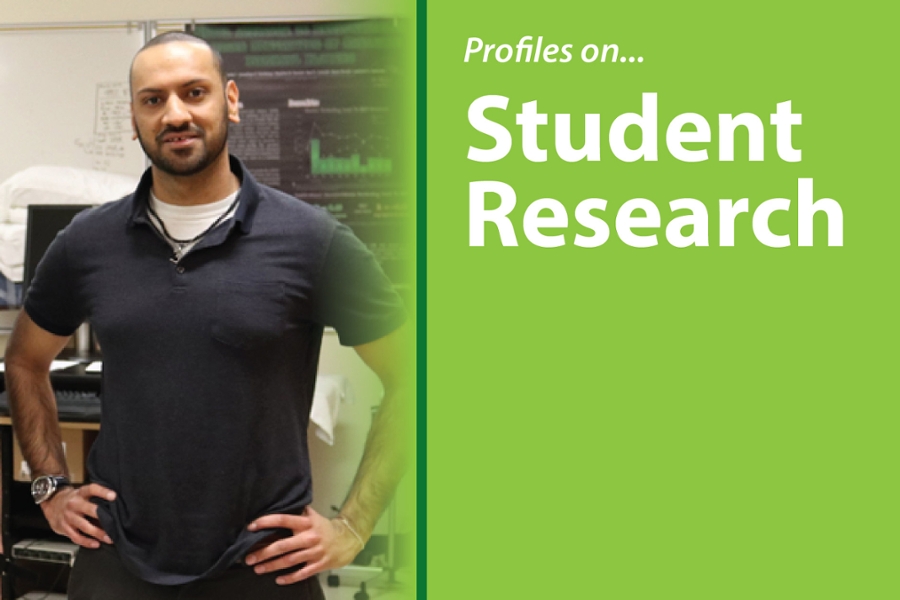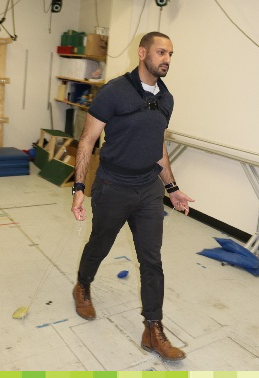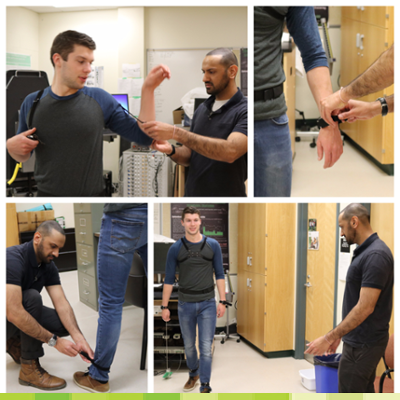
A stride in the right direction
Abhishek Kumar, a Kinesiology Honours student, was awarded first place in the 2017 USSU Undergraduate Project Symposium.
By Megan FairbairnThis article originally appears on the University of Saskatchewan Undergraduate Research page (source).
Abhishek Kumar has long been determined to not only become a practicing physician, but to also uncover clinical applications for cutting-edge biomechanical discoveries. After his in-progress research project earned him first place in the 2017 University of Saskatchewan Students’ Union (USSU) Undergraduate Project Symposium, he is one step closer to his goal.
Anchored to Research

During the summer of 2016, Kumar embarked on a research project, titled: Using one or two arms to add haptic input during walking: Does it matter. This project focused on the effects of haptic perception (touch-based sensory feedback) techniques on the improvement of balance while walking. Although haptic perception may sound like an obscure term, is used by virtually everyone on a daily basis through cell phones and video-game controllers. For example, when you touch the navigation buttons on an Android phone, that little “buzz” you feel is haptic feedback!
The study compared the effectiveness of similar feedback (which was produced by using walking aids) on balance. Two types of aides with one or both arms, anchor-based and rigid-railing, were examined and compared to determine how they affected balance. This research was conducted alongside a team of two undergraduate and one students, and supervisors Drs. Alison Oates and Joel Lanovaz in the College of Kinesiology. The experiment’s results showed that in healthy adults, using walking aids with both arms improved walking balance more than using only one. Furthermore, anchor-based walking aids proved to increase balance due to haptic perception, whereas rigid-railing aids were only effective because of arm placement. Kumar’s work greatly impressed the symposium’s judges, because, as he explained, its implications are directly applicable to medicine and wellness:
“…anchor-based systems can be used in clinical settings to help improve walking balance in certain populations. It may also be helpful to fall-prone seniors (and at-risk populations) to improve walking in their daily lives…Using an anchor-based system is akin to walking a dog outside.”
It is also possible to use these initial discoveries as a springboard to testing further ideas and biotechnological developments:
“The next step [from this experiment] would be to conduct a walking anchor-based intervention research [project] to study the effects of anchors as a possible intervention for improving walking stability in healthy or clinical populations.”
Securing the Win
Kumar was first notified about the opportunity to submit his project in the USSU Project Symposium by supervisor Dr. Oates. They agreed that it would be the perfect opportunity to showcase their project’s most interesting findings, despite the fact that data analysis was still in progress. However, because of the experiment’s volume of data, the team was able to make preliminary conclusions using the processed findings that were most representative of the project. Kumar then translated those results to an academic poster designed around readability, alignment of visual elements, conciseness, and emphasis of the experiment’s most interesting results. Aside from the potential for meaningful application of the project’s findings, part of the team’s enthusiastic presentation also included a live-action video which simulated the different trial techniques and equipment used. This combination of profound research, effortful planning, and dynamic exposition is likely what secured first place for Kumar and his team, proving that there is more to connecting audiences to scientific discovery than data crunching.
Good Medicine
This haptic perception project provided Kumar with something other than a single victory in the Science & Engineering category; it also gave him an opportunity to practice field work in his area of interest while learning to work with human participants – a unique and valuable experience for any aspiring medical student. Interactions with participants aren’t a part of regular coursework, yet provide valuable previews of a student’s ability to follow ethical guidelines and practice appropriate interpersonal skills for doctor-patient relationships. In Kumar’s case, these interactions only served to reinforce his goal of becoming a physician – the varying dynamics that came with each new participant gave life to the more monotonous tasks of research. For instance, during a day of data collection, Kumar and his colleagues kept getting errors while testing one participant; as a result, the participant’s session ended up being 3 hours long! However, Kumar described the participant as being patient, understanding, and having a genuine interest in contributing to the research. This chance for him to relate and adapt to each participant’s case “…made [the project] an even better experience.”
Low-Risk, High-Reward

Many students hesitate to submit in-progress research to poster competitions, turning down opportunities because they are unsure of how to present their research conceptual framework or partial findings. But Kumar’s success shows that when students are willing and able to create dynamic and meaningful presentations, they shouldn’t hold back until their projects are complete. Given a platform, research in progress can convey significant in-progress potential and actual discoveries and spark meaningful conversations and collaborations. Kumar also notes that receiving feedback from peers and judges while in the midst of the research process is extremely beneficial, as it provides fresh insight from objective viewers. In the case of Kumar and his team of biomechanical researchers, their effort was ultimately rewarded with a victory that will fund and foster educational and research opportunities yet to come. This multi-disciplinary undergraduate is now one stable step closer to his medical aspirations.
Abhishek Kumar has a Bachelor of Science (BSc.) Honours in Biotechnology, Microbiology & Immunology, and is currently entering the 4th year of his BSc. Kinesiology degree. In the future, he hopes to be admitted to the U of S College of Medicine.
